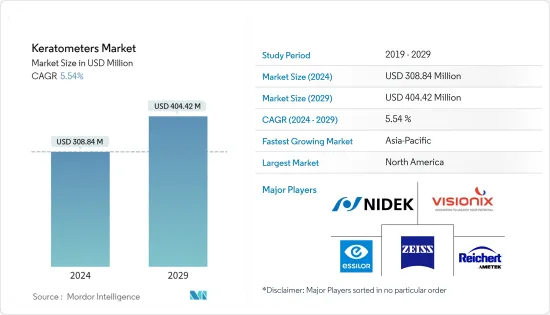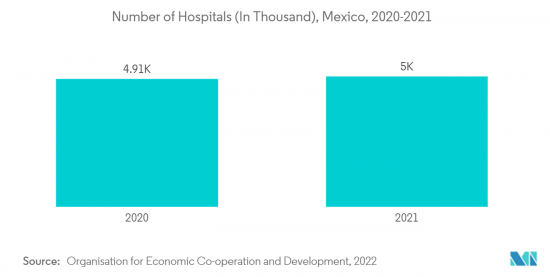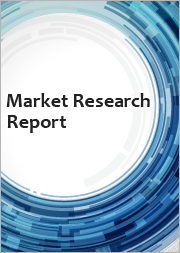
|
시장보고서
상품코드
1407019
각막측정기 시장 : 점유율 분석, 산업 동향 및 통계, 성장 예측(2024-2029년)Keratometers - Market Share Analysis, Industry Trends & Statistics, Growth Forecasts 2024 - 2029 |
||||||
세계의 각막측정기(Keratometers) 시장 규모는 2024년에 3억 884만 달러에 달하고, 2024-2029년의 예측 기간 동안 CAGR 5.54%로 성장하여, 2029년에는 4억 442만 달러에 달할 것으로 예측됩니다.

COVID-19 팬데믹은 COVID-19 이외의 질환의 치료·진단 활동을 혼란시켰습니다. 이것은 세계의 치료 절차와 의약품 및 의료기기 공급망에 영향을 주었고 조사 시장에 악영향을 미쳤습니다. 예를 들어, Carl Zeiss annual report 2022에 따르면, 팬데믹기간 동안 각막측정기를 포함한 안과 의료기기 전략 사업부(SBU)의 수익은 7.3% 감소했습니다. 그러나 2022년도 안과기기 전략 사업부의 매출은 17% 증가했습니다. 이는 팬데믹기간 동안 각막측정기와 같은 안과 의료기기의 매출이 감소했으나 공급망 재개와 의료 시설에서 진단 활동으로 회복되었음을 보여줍니다.
시장을 견인하는 요인으로는 안질환 부담 증가, 투자, 자금, 보조금 증가 등이 있습니다. 눈 질환의 부담이 크므로, 각막측정기 수요가 증가하고, 대폭적인 성장이 예상됩니다. 예를 들어, InSight Vision Center가 2021년 12월에 발표한 보고서에 따르면 6-12개월의 유아의 23%에 일반적인 난시가 포함됩니다. 마찬가지로 WHO의 2022년 10월 보고서에 따르면 세계 약 22억 명이 근시 또는 원시 시력 장애로 고통받고 있으며, 그 중 약 10억 건의 시력 장애를 예방할 수 있습니다. 시력 장애의 부담이 큰 것을 나타냅니다. 각막측정기를 이용한 진단에 대한 높은 수요가 예상되며, 조사 기간 중 시장을 밀어 올릴 가능성이 높습니다.
또한 시장 진출기업의 새로운 전략과 노력이 시장에 큰 영향을 미칠 것으로 예상됩니다. 예를 들어, 2021년 5월, ZEISS는 Capture 3D를 인수하여 산업 품질 및 조사 부문의 미국 전국 커버리지를 확대했습니다. 이 인수를 통해 고객은 최상의 측정 솔루션을 얻기 위한 완벽하고 통합된 경험의 혜택을 누릴 수 있으며 스터드 기간 동안 시장을 홍보할 것으로 기대됩니다.
그러나 저개발국과 신흥국 시장에서는 눈과 관련된 질병에 대한 1차적인 인프라 정비가 필요하며 시장 전체의 성장을 방해하고 있습니다.
각막측정기 시장 동향
예측 기간 동안 병원이 큰 시장 점유율을 차지할 전망
병원 수 증가는 시장 성장의 주요 요인입니다. 병원 수는 미국과 멕시코와 같은 다양한 국가에서 안정적인 속도로 증가하고 있습니다. 예를 들어 미국 병원 협회(American Hospital Association)의 2022년 보고서에 따르면 미국에는 6,093개의 병원이 있습니다. 하지만, 2022년 3월 현재 미국의 7,308개 병원을 추적하고 있습니다. 이 병원 시설은 40개의 공공, 민간 및 독자적인 출처에서 수집됩니다. 투자 증가도 시장 성장 요인 중 하나입니다.
India Brand Equity Foundation이 2021년 12월에 발표한 보고서에 따르면, 산업·국내 무역 진흥국(DPIIT)이 발표한 데이터에 따르면, 의약품·제약 섹터에 대한 외국 직접 투자(FDI) 유입액은 191억 9,000 만미 달러였습니다. 병원, 진단센터, 의료·수술기구 등 분야에 대한 FDI 유입액은 각각 77억 3,000만 달러, 23억 5,000만 달러였습니다.
같은 정보통에 따르면 인도 정부는 국내 헬스케어 인프라를 강화하기 위해 5,000억 루피(68억 달러) 상당의 신용 우대 프로그램을 도입할 예정이라고 합니다. 이 프로그램을 통해 정부는 보증인이 되어 기업이 자금을 활용하여 병원의 용량과 의료용품을 확대할 수 있습니다. 이러한 노력과 투자는 각막계를 포함한 다양한 의료기기를 채택하여 최종 사용자 시설을 늘릴 것입니다. 따라서, 상기 요인은 예측 기간 동안 조사 부문의 성장을 가속할 것으로 예상됩니다.

예측 기간 중 북미가 시장에서 큰 점유율을 차지할 전망
북미는 예측 기간 동안 큰 시장 점유율을 차지할 것으로 예측됩니다. 투자, 안질환 증가, 조사 연구 등 요인이 시장 성장을 증가시킬 가능성이 높습니다. 2023년 3월 CDC의 NCHS에 따르면 안질환과 시력장애 연구자금은 2021년 10억 7,000만 달러였으나 2022년에는 10억 9700만 달러로 증가했으며 2023년에는 11억 6,300만 달러에 달할 것으로 추정되었습니다. 이는 눈 질환 및 시력 장애에 대한 연구 자금이 증가하고 있음을 보여주며, 각막측정기의 사용에 큰 영향을 미치고 예측 기간 동안 시장 성장을 가속할 것으로 예측됩니다.
각막측정기는 각막의 곡률을 측정하고, 각막 난시를 각막 후 난시, 수정체 후 난시와 수정체 전 난시와 함께 산출하지만, 많은 경우, 난시는 최소입니다. 난시는 가장 빈번한 굴절 교정입니다. 유병률 증가는 각막측정기 수요를 증가시키고, 이 지역 시장 성장을 촉진 할 것으로 예상됩니다. 예를 들어 NVISION Eye Centers가 2022년 12월에 발표한 보고서에 따르면 난시는 미국에서 약 3명 중 1명의 비율로 발생하고 있습니다. 또한 원시는 40세 이상의 인구의 약 8.4%에, 근시는 40세 이상의 인구의 약 23.9%에 발생하고 있습니다. 이는 시력장애 부담이 크다는 것을 보여 주며, 각막측정기의 사용률을 높이고 시장 성장을 가속하고 있습니다.
각막측정기 산업 개요
시장은 적당히 통합되어 있으며 여러 대형 기업으로 구성되어 있습니다. 각 회사는 합병, 신제품 출시, 인수, 제휴 등 특정 전략적 이니셔티브를 시행하고 있으며 시장에서 지위 강화에 도움이 됩니다. 또한 주요 기업들이 시작한 R&D 활동 증가는 시장 성장을 뒷받침하고 있습니다. 현재 시장을 독점하고 있는 기업으로는 Carl Zeiss AG, Essilor, Visionix(Luneau Technology), Reichert, Inc., NIDEK 등이 있습니다.
기타 혜택 :
- 엑셀 형식 시장 예측(ME) 시트
- 3개월의 애널리스트 서포트
목차
제1장 서론
- 조사 전제 조건 및 시장 정의
- 조사 범위
제2장 조사 방법
제3장 주요 요약
제4장 시장 역학
- 시장 개요
- 시장 성장 촉진 요인
- 안질환의 부담증
- 안과 의료기기에 대한 투자, 자금, 조성금 증가
- 시장 성장 억제 요인
- 저개발국 및 신흥 국가에서 눈 관련 질환에 대한 주요 인프라의 부족
- Porter's Five Forces 분석
- 공급기업의 협상력
- 구매자/소비자의 협상력
- 신규 참가업체의 위협
- 대체품의 위협
- 경쟁 기업간 경쟁 관계의 강도
제5장 시장 세분화-시장 규모 : 금액별(달러)
- 유형별
- 거치형 각막측정기
- 휴대형 각막측정기
- 최종 사용자별
- 병원
- 안과 클리닉
- 기타
- 지역별
- 북미
- 미국
- 캐나다
- 멕시코
- 유럽
- 독일
- 영국
- 프랑스
- 이탈리아
- 스페인
- 기타 유럽
- 아시아 태평양
- 중국
- 일본
- 인도
- 호주
- 한국
- 기타 아시아 태평양
- 중동 및 아프리카
- GCC
- 남아프리카공화국
- 기타 중동 및 아프리카
- 남미
- 브라질
- 아르헨티나
- 기타 남미
- 북미
제6장 경쟁 구도
- 기업 개요
- Carl Zeiss AG
- Costruzione Strumenti Oftalmici
- Essilor
- Visionix(Luneau Technology)
- Topcon Corporation
- Micro Medical Devices
- Naugra Medical
- NIDEK CO., LTD
- TOMEY GmbH
- Reichert, Inc
- SHIGIYA MACHINERY WORKS LTD GS Division
- Canon Medical Systems Corporation
제7장 시장 기회 및 향후 동향
LYJ 24.01.29
The Keratometers Market size is estimated at USD 308.84 million in 2024, and is expected to reach USD 404.42 million by 2029, growing at a CAGR of 5.54% during the forecast period (2024-2029).
The COVID-19 pandemic disrupted the treatment and diagnostic activities of diseases other than COVID-19. It impacted the treatment procedures and supply chain of pharmaceuticals and medical devices worldwide, adversely impacting the studied market. For instance, according to the Carl Zeiss annual report 2022, the revenue in the ophthalmic devices strategic business unit (SBU), including keratometers, decreased by -7.3% during the pandemic. However, the revenue from the ophthalmic devices strategic business unit increased by 17% in FY2022. It shows the declined sales revenue of ophthalmic devices like keratometers during the pandemic, which recovered due to a resumed supply chain and diagnostic activities in the healthcare facilities.
The factors driving the market include the increasing burden of eye disorders and growing investments, funds, and grants. The high burden of eye disorders increases the demand for keratometers, which is expected to grow significantly. For instance, as per the report published by InSight Vision Center in December 2021, 23% of infants aged 6 to 12 months would include common astigmatism. Similarly, according to the October 2022 report of the WHO, about 2.2 billion people around the world suffer from near or distant vision impairment, of which approximately 1 billion cases of vision impairment can be prevented. It shows the high burden of the cases of vision impairment. It is expected to include a high demand for the diagnosis using keratometers and likely boost the market over the study period.
Furthermore, the new strategies and initiatives by the market players are expected to significantly impact the market. For instance, in May 2021, ZEISS expanded its national coverage in the United States for its Industrial Quality & Research segment by acquiring Capture 3D. With this acquisition, customers benefitted from a seamless, integrated experience to get the best measuring solutions, and it is expected to propel the market over the stud period.
However, the need for primary infrastructure for eye-related diseases in underdeveloped and developing countries hampers overall market growth.
Keratometers Market Trends
Hospitals are Expected to Hold a Significant Market Share Over the Forecast Period
The increasing number of hospitals is the primary factor for market growth. The number of hospitals is growing at a steady pace in various countries like the United States and Mexico. For instance, according to the American Hospital Association 2022 report, there are 6,093 hospitals in the United States. However, the Definitive Healthcare HospitalView product tracks 7,308 active United States hospitals as of March 2022. These hospital facilities are curated from 40 public, private, and proprietary sources. Increasing investment is another factor for market growth.
The report published by India Brand Equity Foundation in December 2021 stated that Foreign Direct Investment (FDI) inflows for the drugs and pharmaceuticals sector stood at USD 19.19 billion, according to the data released by the Department for Promotion of Industry and Internal Trade (DPIIT). FDI inflows in sectors such as hospitals, diagnostic centers, and medical and surgical appliances stood at USD 7.73 billion and USD 2.35 billion, respectively.
The same source stated that the Indian government plans to introduce a credit incentive program worth INR 500 billion (USD 6.8 billion) to boost the country's healthcare infrastructure. The program will allow firms to leverage the fund to expand hospital capacity or medical supplies, with the government acting as a guarantor. Such initiatives and investments would increase the end-user facilities by adopting various medical devices, including keratometers. Hence, the factors mentioned above are expected to drive the growth of the studied segment during the forecast period.

North America is Expected to Hold the Significant Share in the Market Over the Forecast Period
The North American region is expected to hold a significant market share over the forecast period. Factors such as investments, increasing eye disorders, and research studies will likely increase market growth. According to the NCHS at CDC in March 2023, the research funding for eye disease and disorders of vision was USD 1,070 million in 2021, which was increased to USD 1,097 million in 2022 and is estimated to be USD 1,163 million in 2023. It shows the increasing research funding on eye disease and vision disorders, which is expected to significantly impact keratometer usage, propelling the market's growth over the forecast period.
Keratometry measures the cornea's curvature to calculate corneal astigmatism along with posterior corneal astigmatism and posterior and anterior crystalline lens astigmatism, which is minimal in many cases. Astigmatism is the most frequent ammetropia. Increasing prevalence will increase the demand for keratometers, which is expected to boost the market's growth in the region. For instance, as per the report published by NVISION Eye Centers in December 2022, astigmatism occurs in about one out of every three people in the United States. In addition, farsightedness occurs in about 8.4% of the population over 40, and nearsightedness occurs in about 23.9% of the population over 40 years old. It shows the high burden of vision impairment, which increases keratometers' usage and propels market growth.
Keratometers Industry Overview
The market is moderately consolidated and consists of several major players. The companies are implementing certain strategic initiatives, such as mergers, new product launches, acquisitions, and partnerships, that help them strengthen their market positions. Further, the increase in research and development activities initiated by the key players also favors market growth. Some companies currently dominating the market are Carl Zeiss AG, Essilor, Visionix (Luneau Technology), Reichert, Inc., and NIDEK CO., LTD.
Additional Benefits:
- The market estimate (ME) sheet in Excel format
- 3 months of analyst support
TABLE OF CONTENTS
1 INTRODUCTION
- 1.1 Study Assumptions and Market Definition
- 1.2 Scope of the Study
2 RESEARCH METHODOLOGY
3 EXECUTIVE SUMMARY
4 MARKET DYNAMICS
- 4.1 Market Overview
- 4.2 Market Drivers
- 4.2.1 Increasing Burden of Eye Disorders
- 4.2.2 Growing Investments, Funds, and Grants on Eye Care Devices
- 4.3 Market Restraints
- 4.3.1 Lack of Primary Infrastructure For Eye Related Diseases in Underdeveloped and Developing Countries
- 4.4 Porter's Five Forces Analysis
- 4.4.1 Bargaining Power of Suppliers
- 4.4.2 Bargaining Power of Buyers/Consumers
- 4.4.3 Threat of New Entrants
- 4.4.4 Threat of Substitute Products
- 4.4.5 Intensity of Competitive Rivalry
5 MARKET SEGMENTATION (Market Size by Value - USD)
- 5.1 By Type
- 5.1.1 Stationary Type Keratometers
- 5.1.2 Portable Type Keratometers
- 5.2 By End User
- 5.2.1 Hospitals
- 5.2.2 Eye Clinics
- 5.2.3 Others
- 5.3 Geography
- 5.3.1 North America
- 5.3.1.1 United States
- 5.3.1.2 Canada
- 5.3.1.3 Mexico
- 5.3.2 Europe
- 5.3.2.1 Germany
- 5.3.2.2 United Kingdom
- 5.3.2.3 France
- 5.3.2.4 Italy
- 5.3.2.5 Spain
- 5.3.2.6 Rest of Europe
- 5.3.3 Asia-Pacific
- 5.3.3.1 China
- 5.3.3.2 Japan
- 5.3.3.3 India
- 5.3.3.4 Australia
- 5.3.3.5 South Korea
- 5.3.3.6 Rest of Asia-Pacific
- 5.3.4 Middle East and Africa
- 5.3.4.1 GCC
- 5.3.4.2 South Africa
- 5.3.4.3 Rest of Middle East and Africa
- 5.3.5 South America
- 5.3.5.1 Brazil
- 5.3.5.2 Argentina
- 5.3.5.3 Rest of South America
- 5.3.1 North America
6 COMPETITIVE LANDSCAPE
- 6.1 Company Profiles
- 6.1.1 Carl Zeiss AG
- 6.1.2 Costruzione Strumenti Oftalmici
- 6.1.3 Essilor
- 6.1.4 Visionix (Luneau Technology)
- 6.1.5 Topcon Corporation
- 6.1.6 Micro Medical Devices
- 6.1.7 Naugra Medical
- 6.1.8 NIDEK CO., LTD
- 6.1.9 TOMEY GmbH
- 6.1.10 Reichert, Inc
- 6.1.11 SHIGIYA MACHINERY WORKS LTD GS Division
- 6.1.12 Canon Medical Systems Corporation
















